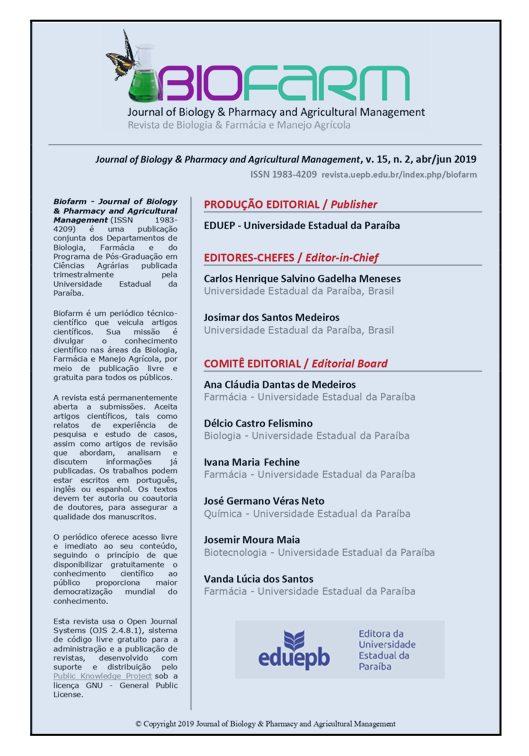AVALIAÇÃO DA SÍNDROME METABÓLICA ATRAVÉS DOS CRITÉRIOS DIAGNÓSTICOS DO NCEP – ATP III E DA IDF
Resumo
A Síndrome Metabólica (SM) representa a anormalidade metabólica mais comum de maior responsabilidade por eventos cardiovasculares. Desenvolve-se da predisposição genética e fatores ligados ao estilo de vida, sendo uma doença multifatorial. Dentre os Fatores de Risco (FR), destacam-se: Resistência à Insulina (RI), Diabetes Mellitus tipo 2 (DM2), hipertrigliceridemia, HDL-colesterol (HDL-c) diminuído, Obesidade Central (OC) e Hipertensão Arterial Sistêmica (HAS). Para diagnosticar a SM foram empregados os critérios da National Cholesterol Education Program Adult Treatment Panel III (NCEP-ATP III) e os da Federação Internacional de Diabetes (IDF) diferindo, os componentes essenciais e pontos de corte para cada. O estudo foi transversal e documental, quantitativo e descritivo, realizado de fevereiro a maio de 2017, em Galante, distrito de Campina Grande-PB. Foi utilizado o teste χ² para comparar proporções, sendo considerada a significância p< 0,05. A mostra foi composta por 106 pacientes, sendo 97% classificados segundo o IDF e 88% pelo NCEP-ATP III. A prevalência da SM, avaliada pelos critérios da IDF foi significativamente maior do que o do NCEP-ATP III (97% vs 88%). As mulheres foram maioria com idade média de 64 anos. As variáveis pressóricas e bioquímicas apresentaram médias elevadas. Os componentes avaliados pelo IDF e NCEP-ATP III demonstraram maior frequência para ambos os gêneros. Assim, a associação de tratamentos deve ser intensificada minimizando agravos que resultem em invalidez ou óbito.
Downloads
Publicado
Como Citar
Edição
Seção
Licença
Copyright (c) 2023 BIOFARM - Journal of Biology & Pharmacy and Agricultural Management

Este trabalho está licenciado sob uma licença Creative Commons Attribution 4.0 International License.
Authors and co-authors retain copyright, but cede the right to first publication to the Journal of Biology & Pharmacy and Agricultural Management (BIOFARM).
Copyright encompasses exclusive rights to reproduce and deliver the article in all form and media, including reprints, photographs, microfilms and any other similar reproductions, as well as translations. The reproduction of any part of this journal, its storage in databases and its transmission by any form or media - such as electronic, electrostatic and mechanical copies, photocopies, recordings, magnetic media, etc. - will be allowed only with a written permission from the BIOFARM.
Articles published in BIOFARM will be Open-Access articles distributed under the terms and conditions of the Creative Commons Attribution License (CC BY). The copyright is retained by the author(s). BIOFARM will insert the following note at the end of the published text:
© 2023 by the authors; licensee BIOFARM, Campina Grande, Brazil. This article is an open access article distributed under the terms and conditions of the Creative Commons Attribution License (http://creativecommons.org/licenses/by/4.0/).


